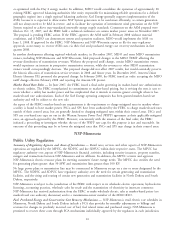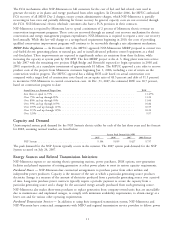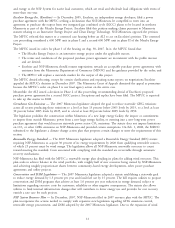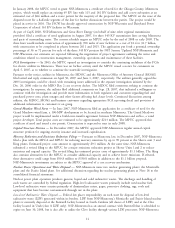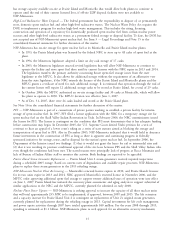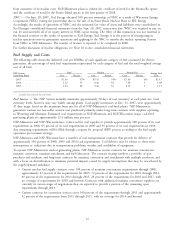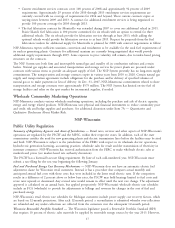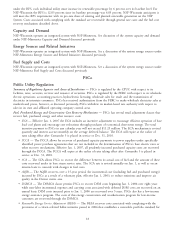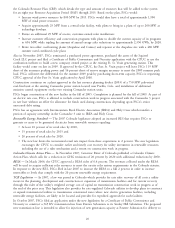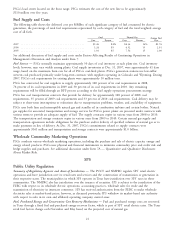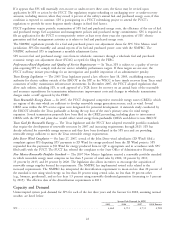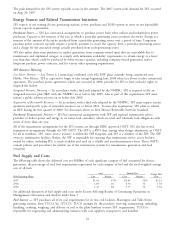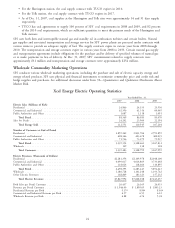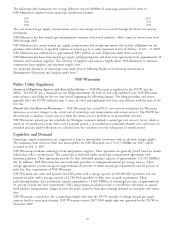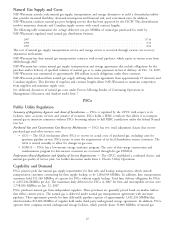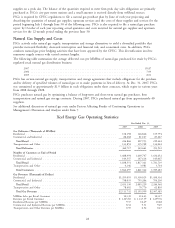Xcel Energy 2007 Annual Report Download - page 30
Download and view the complete annual report
Please find page 30 of the 2007 Xcel Energy annual report below. You can navigate through the pages in the report by either clicking on the pages listed below, or by using the keyword search tool below to find specific information within the annual report.the Colorado Resource Plan (CRP), which details the type and amount of resources that will be added to the system
for an eight year Resource Acquisition Period (RAP) through 2015. Based on the plan, PSCo would:
• Increase wind power resources by 800 MW by 2015. PSCo would then have a total of approximately 1,900
MW of wind power resources.
• Acquire approximately 25 MW from a central solar facility, with plans to bring in a plant of up to 200 MW as
technology develops.
• Pursue an additional 29 MW of on-site, customer-owned solar installations.
• Increase customer efficiency and conservation programs with plans to double the current capacity of its programs
to 694 MW, while tripling the amount of annual energy sales reductions to approximately 2,350 GWh, by 2020.
• Retire two older coal-burning plants (Arapahoe and Cameo) and repower at the Arapahoe site with a 480 MW
summer rated combined cycle plant.
Also in November 2007, PSCo terminated a purchased power agreement, purchased the assets of the Squirrel
Creek LLC project and filed a Certificate of Public Convenience and Necessity application with the CPUC to use the
combustion turbines to build a new, company owned project at the existing Ft. St. Vrain generating station. This
facility would come on line in 2009. If approved by the CPUC, the Fort St. Vrain project will leave PSCo 119 MW
short of the necessary peaking power and 16 percent short of reserve margin necessary to meet the 2009 summer peak
load. PSCo will meet the differential for the summer 2009 peak by purchasing short-term capacity. PSCo is requesting
CPUC approval of the Fort St. Vrain application by April 2008.
Construction continues on a plant approved in the last resource planning docket (2003) of a 750 MW pulverized
coal-fired unit at the existing Comanche power station located near Pueblo, Colo. and installation of additional
emission control equipment on the two existing Comanche station units.
PSCo began construction of the new facility in the fall of 2005. Completion is planned for the fall of 2009. As part of
an electric rate case, PSCo is allowed to include construction work in progress associated with the Comanche 3 project
in rate base without an offset for allowance for funds used during construction, depending upon PSCo’s senior
unsecured debt rating.
PSCo has an agreement with Intermountain Rural Electric Association (IREA) and Holy Cross which transfers a
portion of capacity ownership in the Comanche 3 unit to IREA and Holy Cross.
Renewable Energy Standard — The 2007 Colorado legislature adopted an increased RES that requires PSCo to
generate or cause to be generated electricity from renewable resources equaling:
• At least 10 percent of its retail sales by 2010,
• 15 percent of retail sales by 2015 and
• 20 percent of retail sales by 2020.
• The new law limits the incremental retail rate impact from these acquisitions to 2 percent. The new legislation
encourages the CPUC to consider earlier and timely cost recovery for utility investment in renewable resources,
including the use of a rider mechanism and a return on construction work in progress.
Colorado Climate Action Plan — In November 2007, Governor Ritter of Colorado published a Colorado Climate
Action Plan, which calls for a reduction in GHG emissions of 20 percent by 2020 with additional reductions by 2050.
RESA — In March 2006, the CPUC approved a RESA rider of 0.6 percent. The revenues collected under the RESA
will be used to acquire sufficient solar resources to meet the on-site solar system requirements in the Colorado statutes.
In response to the new RES, PSCo filed in late 2007 to increase the RESA to a full 2 percent in order to increase
renewables to levels that comply with the 20 percent renewable energy requirement.
TCR Legislation — In 2007, a law was passed in Colorado which provides for rate rider recovery of all costs a utility
incurs in the planning, development and construction or expansion of transmission facilities and for current recovery
through this rider of the utility’s weighted average cost of capital on transmission construction work in progress as of
the end of the prior year. This legislation also provides for rate-regulated Colorado utilities to develop plans to construct
or expand transmission facilities to transmission constrained zones where new electric generation facilities, including
renewable energy facilities, are likely to be located and provides for expedited approvals for such facilities.
In October 2007, PSCo filed an application under the new legislation for a Certificate of Public Convenience and
Necessity to construct a 345 KV transmission line from Pawnee Substation to its Smoky Hill Substation. The proposed
new transmission line is intended to allow for injection of new generation capacity at Pawnee Substation for delivery to
20


